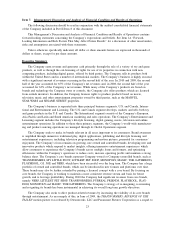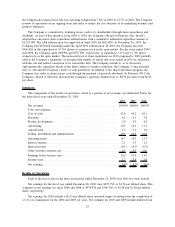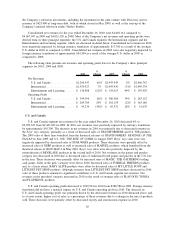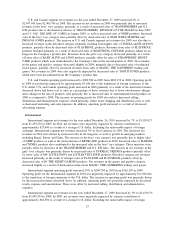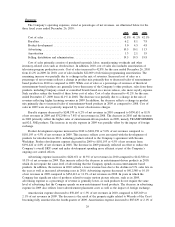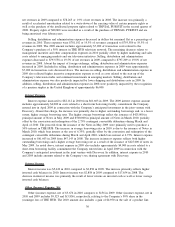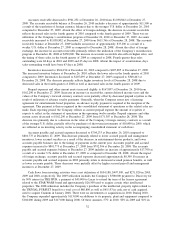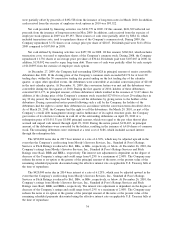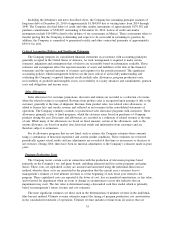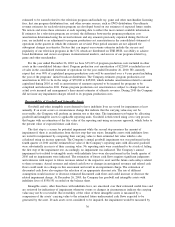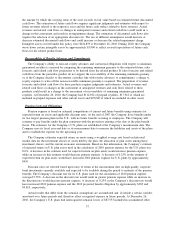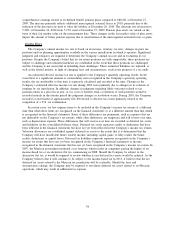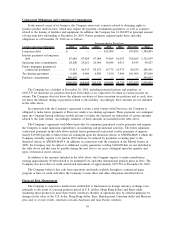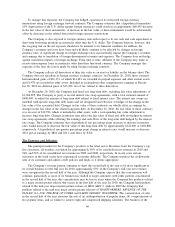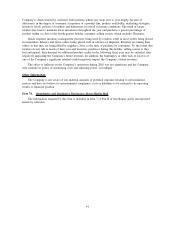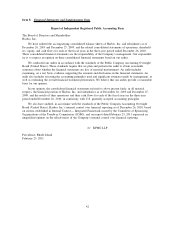Hasbro 2010 Annual Report Download - page 43
Download and view the complete annual report
Please find page 43 of the 2010 Hasbro annual report below. You can navigate through the pages in the report by either clicking on the pages listed below, or by using the keyword search tool below to find specific information within the annual report.2008 were for purchases of tools, dies and molds related to the Company’s products. In 2011, the Company
expects capital expenditures to be in the range of $125,000 to $135,000. During the three years ended
December 26, 2010, depreciation of plant and equipment was $95,925, $95,934 and $87,873, respectively.
The Company commits to inventory production, advertising and marketing expenditures prior to the peak
third and fourth quarter retail selling season. Accounts receivable increase during the third and fourth quarter
as customers increase their purchases to meet expected consumer demand in the holiday season. Due to the
concentrated timeframe of this selling period, payments for these accounts receivable are generally not due
until the fourth quarter or early in the first quarter of the subsequent year. This timing difference between
expenditures and cash collections on accounts receivable makes it necessary for the Company to borrow higher
amounts during the latter part of the year. During 2010, 2009 and 2008, the Company primarily utilized cash
from operations, borrowings under its available lines of credit and its accounts receivable securitization
program to fund its operations.
During 2010, 2009 and 2008, the Company was party to an accounts receivable securitization program
whereby the Company sold, on an ongoing basis, substantially all of its U.S. trade accounts receivable to a
bankruptcy remote special purpose entity, Hasbro Receivables Funding, LLC (“HRF”). HRF was consolidated
with the Company for financial reporting purposes. The securitization program then allowed HRF to sell, on a
revolving basis, an undivided fractional ownership interest of up to $250,000 in the eligible receivables it held
to certain bank conduits. The program provided the Company with a source of working capital. Based on the
amount of eligible accounts receivable as of December 26, 2010, the Company had availability under this
program to sell $250,000, of which no amounts were utilized. In January 2011, the Company terminated this
facility.
On December 16, 2010, the Company entered into a revolving credit agreement (the “Agreement”) which
provides it with a $500,000 committed borrowing facility through December of 2014. The Agreement replaced
the Company’s previous revolving credit agreement. The Agreement contains certain financial covenants
setting forth leverage and coverage requirements, and certain other limitations typical of an investment grade
facility, including with respect to liens, mergers and incurrence of indebtedness. The Company was in
compliance with all covenants in the Agreement, as well as the covenants in the prior revolving credit
agreement for that portion of 2010 that it was effective, as of and for the fiscal year ended December 26,
2010. The Company had no borrowings outstanding under its committed revolving credit facility at
December 26, 2010. However, letters of credit outstanding under this facility as of December 26, 2010 were
approximately $1,400. Amounts available and unused under the committed line at December 26, 2010 were
approximately $498,600. The Company also has other uncommitted lines from various banks, of which
approximately $77,700 was utilized at December 26, 2010. Of the amount utilized under the uncommitted
lines, approximately $14,400 and $63,300 represent outstanding short-term borrowings and letters of credit,
respectively.
In January 2011, the Company entered into an agreement with a group of banks to establish a commercial
paper program (the “Program”). Under the Program, at the request of the Company and subject to market
conditions, the banks may either purchase from the Company, or arrange for the sale by the Company, of
unsecured commercial paper notes. Under the Program, the Company may issue notes from time to time up to
an aggregate principal amount outstanding at any given time of $500,000. The maturities of the notes may
vary but may not exceed 397 days. The notes will be sold under customary terms in the commercial paper
market and will be issued at a discount to par, or alternatively, will be sold at par and will bear varying
interest rates based on a fixed or floating rate basis. The interest rates will vary based on market conditions
and the ratings assigned to the notes by the credit rating agencies at the time of issuance.
Net cash utilized by financing activities was $170,595 in 2010. Of this amount, $639,563 reflects cash
paid, including transaction costs, to repurchase the Company’s common stock. During 2010, the Company
repurchased 15,763 shares at an average price of $40.37. At December 26, 2010, $150,068 remained under the
April 2010 authorization. Dividends paid were $133,048 in 2010 compared to $111,458 in 2009 reflecting the
increase in the Company’s dividend rate in 2010 to $0.25 per quarter from $0.20 per quarter. These utilizations
33


